Research Guide
Chapter 5 sections of a paper.
Now that you have identified your research question, have compiled the data you need, and have a clear argument and roadmap, it is time for you to write. In this Module, I will briefly explain how to develop different sections of your research paper. I devote a different chapter to the empirical section. Please take into account that these are guidelines to follow in the different section, but you need to adapt them to the specific context of your paper.

5.1 The Abstract
The abstract of a research paper contains the most critical aspects of the paper: your research question, the context (country/population/subjects and period) analyzed, the findings, and the main conclusion. You have about 250 characters to attract the attention of the readers. Many times (in fact, most of the time), readers will only read the abstract. You need to “sell” your argument and entice them to continue reading. Thus, abstracts require good and direct writing. Use journalistic style. Go straight to the point.
There are two ways in which an abstract can start:
By introducing what motivates the research question. This is relevant when some context may be needed. When there is ‘something superior’ motivating your project. Use this strategy with care, as you may confuse the reader who may have a hard time understanding your research question.
By introducing your research question. This is the best way to attract the attention of your readers, as they can understand the main objective of the paper from the beginning. When the question is clear and straightforward this is the best method to follow.
Regardless of the path you follow, make sure that the abstract only includes short sentences written in active voice and present tense. Remember: Readers are very impatient. They will only skim the papers. You should make it simple for readers to find all the necessary information.
5.2 The Introduction
The introduction represents the most important section of your research paper. Whereas your title and abstract guide the readers towards the paper, the introduction should convince them to stay and read the rest of it. This section represents your opportunity to state your research question and link it to the bigger issue (why does your research matter?), how will you respond it (your empirical methods and the theory behind), your findings, and your contribution to the literature on that issue.
I reviewed the “Introduction Formulas” guidelines by Keith Head , David Evans and Jessica B. Hoel and compiled their ideas in this document, based on what my I have seen is used in papers in political economy, and development economics.
This is not a set of rules, as papers may differ depending on the methods and specific characteristics of the field, but it can work as a guideline. An important takeaway is that the introduction will be the section that deserves most of the attention in your paper. You can write it first, but you need to go back to it as you make progress in the rest of teh paper. Keith Head puts it excellent by saying that this exercise (going back and forth) is mostly useful to remind you what are you doing in the paper and why.
5.2.1 Outline
What are the sections generally included in well-written introductions? According to the analysis of what different authors suggest, a well-written introduction includes the following sections:
- Hook: Motivation, puzzle. (1-2 paragraphs)
- Research Question: What is the paper doing? (1 paragraph)
- Antecedents: (optional) How your paper is linked to the bigger issue. Theory. (1-2 paragraphs)
- Empirical approach: Method X, country Y, dataset Z. (1-2 paragraphs)
- Detailed results: Don’t make the readers wait. (2-3 paragraphs)
- Mechanisms, robustness and limitations: (optional) Your results are valid and important (1 paragraph)
- Value added: Why is your paper important? How is it contributing to the field? (1-3 paragraphs)
- Roadmap A convention (1 paragraph)
Now, let’s describe the different sections with more detail.
5.2.1.1 1. The Hook
Your first paragraph(s) should attract the attention of the readers, showing them why your research topic is important. Some attributes here are:
- Big issue, specific angle: This is the big problem, here is this aspect of the problem (that your research tackles)
- Big puzzle: There is no single explanation of the problem (you will address that)
- Major policy implemented: Here is the issue and the policy implemented (you will test if if worked)
- Controversial debate: some argue X, others argue Y
5.2.1.2 2. Research Question
After the issue has been introduced, you need to clearly state your research question; tell the reader what does the paper researches. Some words that may work here are:
- I (We) focus on
- This paper asks whether
- In this paper,
- Given the gaps in knoweldge, this paper
- This paper investigates
5.2.1.3 3. Antecedents (Optional section)
I included this section as optional as it is not always included, but it may help to center the paper in the literature on the field.
However, an important warning needs to be placed here. Remember that the introduction is limited and you need to use it to highlight your work and not someone else’s. So, when the section is included, it is important to:
- Avoid discussing paper that are not part of the larger narrative that surrounds your work
- Use it to notice the gaps that exist in the current literature and that your paper is covering
In this section, you may also want to include a description of theoretical framework of your paper and/or a short description of a story example that frames your work.
5.2.1.4 4. Empirical Approach
One of the most important sections of the paper, particularly if you are trying to infer causality. Here, you need to explain how you are going to answer the research question you introduced earlier. This section of the introduction needs to be succint but clear and indicate your methodology, case selection, and the data used.
5.2.1.5 5. Overview of the Results
Let’s be honest. A large proportion of the readers will not go over the whole article. Readers need to understand what you’re doing, how and what did you obtain in the (brief) time they will allocate to read your paper (some eager readers may go back to some sections of the paper). So, you want to introduce your results early on (another reason you may want to go back to the introduction multiple times). Highlight the results that are more interesting and link them to the context.
According to David Evans , some authors prefer to alternate between the introduction of one of the empirical strategies, to those results, and then they introduce another empirical strategy and the results. This strategy may be useful if different empirical methodologies are used.
5.2.1.6 6. Mechanisms, Robustness and Limitations (Optional Section)
If you have some ideas about what drives your results (the mechanisms involved), you may want to indicate that here. Some of the current critiques towards economics (and probably social sciences in general) has been the strong focus on establishing causation, with little regard to the context surrounding this (if you want to hear more, there is this thread from Dani Rodrick ). Agency matters and if the paper can say something about this (sometimes this goes beyond our research), you should indicate it in the introduction.
You may also want to briefly indicate how your results are valid after trying different specifications or sources of data (this is called Robustness checks). But you also want to be honest about the limitations of your research. But here, do not diminish the importance of your project. After you indicate the limitations, finish the paragraph restating the importance of your findings.
5.2.1.7 7. Value Added
A very important section in the introduction, these paragraphs help readers (and reviewers) to show why is your work important. What are the specific contributions of your paper?
This section is different from section 3 in that it points out the detailed additions you are making to the field with your research. Both sections can be connected if that fits your paper, but it is quite important that you keep the focus on the contributions of your paper, even if you discuss some literature connected to it, but always with the focus of showing what your paper adds. References (literature review) should come after in the paper.
5.2.1.8 8. Roadmap
A convention for the papers, this section needs to be kept short and outline the organization of the paper. To make it more useful, you can highlight some details that might be important in certain sections. But you want to keep this section succint (most readers skip this paragraph altogether).
5.2.2 In summary
The introduction of your paper will play a huge role in defining the future of your paper. Do not waste this opportunity and use it as well as your North Star guiding your path throughout the rest of the paper.
5.3 Context (Literature Review)
Do you need a literature review section?
5.4 Conclusion
Thesis Writing: What to Write in Chapter 5
Table of contents, introduction.
This article tells what a budding researcher must include in Chapter 5-the Summary. It also includes the tense of the verb and the semantic markers, which are predominantly used in writing the summary, conclusions, and recommendations.
For others, writing Chapter 5 is the easiest part of thesis writing, but there are groups of students who would like to know more about it. If you are one of them, this article on how to write chapter 5 of your thesis is purposely written for you.
What to Write in Chapter 5
1. write the summary.
Your summary in Chapter 5 may include:
- objectives of the study.
- statement of the problem.
- respondents.
- sampling procedures.
- method/s of research employed.
- statistical treatment/s applied, or hypotheses tested, if there is any; and
If you notice, all the parts mentioned above are already included in your Chapters 1- 4. So, the challenge is on how you are going to write and present it in Chapter 5 briefly.
First, you must go directly to the point of highlighting the main points. There is no need to explain the details thoroughly. You must avoid copying and pasting what you have written in the previous chapters. Just KISS (keep it short and simple)!
Then, write sentences in simple past and always use passive voice construction rather than the active voice. You must also be familiar with the different semantic markers.
When I was enrolled in Academic Writing in my master’s degree, I learned that there are semantic markers which can be used in order not to repeat the same words or phrases such as additionally, also, further, in addition to, moreover, contrary to, with regard to, as regards, however, finally, during the past ___ years, from 1996 to 2006, after 10 years, as shown in, as presented in, consequently, nevertheless, in fact, on the other hand, subsequently and nonetheless.
Next, you may use the following guide questions to check that you have not missed anything in writing the summary:
- What is the objective of the study?;
- Who/what is the focus of the study?;
- Where and when was the investigation conducted?;
- What method of research was used?;
- How were the research data gathered?;
- How were the respondents chosen?;
- What were the statistical tools applied to treat the collected data?; and
- Based on the data presented and analyzed, what findings can you summarize?
Finally, organize the summary of the results of your study according to the way the questions are sequenced in the statement of the problem.
2. Write the Conclusion or Conclusions

Once you have written the summary in Chapter 5, draw out a conclusion from each finding or result. It can be done per question, or you may arrange the questions per topic or sub-topic if there is any. But if your research is quantitative, answer the research question directly and tell if the hypothesis is rejected or accepted based on the findings.
As to grammar, make sure that you use the present tense of the verb because it comprises a general statement of the theory or the principle newly derived from the present study. So, don’t be confused because, in your summary, you use past tense, while in conclusion; you use the present tense.
3. Write the Recommendations
The recommendations must contain practical suggestions that will improve the situation or solve the problem investigated in the study.
First, it must be logical, specific, attainable, and relevant. Second, it should be addressed to persons, organizations, or agencies directly concerned with the issues or to those who can immediately implement the recommended solutions. Third, present another topic which is very relevant to the present study that can be further investigated by future researchers.
But never recommend anything that is not part of your study or not being mentioned in your findings.
First, it must be logical, specific, attainable, and relevant. Second, it should be addressed to persons, organizations, or agencies directly concerned with the issues or to those who can immediately implement the recommended solutions. Third, present another topic that is very relevant to the present study that can be further investigated by future researchers.
Recommend nothing that is not part of your research or not being mentioned in your findings.
However, there are universities, especially in the Philippines, that require a specific thesis format to be followed by students. Thus, as a student, you must conform to the prescribed form of your college or university.
Nordquist, R. n.d. Imperative Mood. Retrieved July 29, 2014, from https://www.thoughtco.com/imperative-mood-grammar-1691151
© 2014 July 29 M. G. Alvior | Updated 2024 January 10
Related Posts
How to write a thesis statement.

MA in Curriculum and Instruction: Why is it so important?
Great ways to present your data, about the author, mary g. alvior, phd.
Dr. Mary Gillesania Alvior has PhD in Curriculum Development from West Visayas State University. She earned her Master of Arts in Teaching English from De La Salle University, Manila as Commission on Higher Education (CHED) scholar. As academic advisor, she helps learners succeed in their academic careers by providing them the necessary skills and tips in order to survive in this wobbling financial environment. In 2014, she got involved in the establishment of a language institute in the Middle East, particularly in the use of Common European Framework of Reference for Languages (CEFR). Then she went to Thailand and became a lecturer in the international college and handled English and Graduate Education courses. From 2017 to 2021, she became the Focal Person for the Establishment of a Medical School, Director of Curriculum and Instructional Materials Development Office (CIMDO), Head of BAC Secretariat, Quality Management System (QMS) Leader, and TWG member of the Procurement for Medical Equipment. Currently, she is the coordinator of the Project Management Committee for the Establishment of the Medical School. In spite of numerous tasks, she is into data privacy, quality management system, and space industry.
100 Comments
can you please make a summary about “Centella Asiatica with virgin Coconut Oil as Ointment”?
I am still having problem in organizing my summary and conclusion (my topic is dress code in public schools. to be more specific, at the Voinjama Public School. Can you help me with a sample?
This is very helpful especially the grammar part. It really jumped start my writing effort… really want to finish my study with style.
I just pray you are okay. Thanks for responding to the questions, I have also learnt a lot.
Hello, Daryl. Thank you so much. About your request, I will find time to write about it. I got so busy the past months.
Precise and direct to the point ,, Thanks maam Mary.
Thanks very much for this all importing information on how to write chapter five in thesis writing. It gives me more insight as to how to develop the chapter five perfectly.
Hello maam my PhD research purely a qualitative study on community based organization of slum ..i used 3 tool case study , participant observation and FGDs to analyse role, impact, challenge and aspiration of CBOs . i used tabular form (matrix to analyse ) did not use any software..
PLEASE HELP/GUIDE ME WHAT SHOULD I WRITE in my Chapter 5 .. your help is very much crucial as i have to submit thesis this weekend KULDEEP
I’m so sorry, Kuldeep. I wish you are done with your doctorate research. It is been a year then. I got sick and had a lot of work to do. God bless!
Hello ma’am, can I ask about in what part the recommendation in chapter 1 reflect the recommendation in chapter5? Thanks.
Sorry, Aly. This is very late. Take your statement of the problem. the results for the statement of the problem will be the basis for your recommendation.
You are welcome, Prince. God bless to your research endeavor.
Thank you very much very insightful.
Eric, you are welcome. I wish you are able to finish your work.
how to write a recommendation, my title is common causes of financial problem. Hope you can help me…
Hello, Jolven. Your recommendation must be based on your findings. So, if that is your title, and you found that the common causes are the ——-, then write a recommendation based on the causes.
Thanks a lot, Mimimi.
Main navigation
- Current Projects
- Past Projects
- Publications
- News & Events
- Student Research
- List of theses (with abstracts)
- Le droit au logement en France
- Neighborhood Regeneration in Beijing
- Segregation of Women in Islamic Societies of South Asia...
- Practice of Community Architecture
- Alternatives to Home Ownership
- Lilong Housing, A Traditional Settlement Form
- Improving Sanitation in Coastal Communities...
- Settlement Patterns in Unplanned Areas
- Contents and introduction
- Chapter 3 (part 2)
- Urban Renewal in Beijing, Observation and Analysis
Chapter 5: Conclusion, Interpretation and Discussion
Introduction.
The following chapter concludes this report. A summary of the research is presented, and findings of the study are discussed and interpreted. The significance of this research in the immediate context of El Gallo and in the field of low-income housing is examined. Recommendations for further research end the chapter.
The scope of the following conclusions is limited to the context and historical characteristics of El Gallo. Thus, applied to other situations, these conclusions may yield incorrect assumptions. Still, these conclusions are relevant to the process of dwelling evolution in progressive development projects.
5.1 Summary of Research
This study observed the process of dwelling evolution in progressive development projects. The literature review was concentrated on the process of progressive development occurring in planned sponsored projects. It was found that, based on observations of the informal settlement process, progressive development under different contextual conditions was not questioned, and its benefits were taken for granted. Studies in the area were reduced to the period of improvement up to the time when the dwelling was physically consolidated. Longer term evaluation of progressive development projects were not found.
Research was undertaken on a 27-year-old progressive development project in Venezuela. The intention was to observe the process of dwelling evolution and the kind of housing that was being produced under progressive urban development projects on a long-term basis. The case study showed dwellings built with different initial levels of user-participation. Dwelling evolution was observed in a survey sample using parameters relevant to the case study (i.e., area increase, dwelling spatial growth and plot occupation, and changes in the functional structure).
Survey dwellings followed identifiable patterns of evolution in size, spatial structure and use-layout. Patterns were affected by aspects of the surrounding context and by aspects inherent to characteristics of the initial dwelling. Consequently, different dwelling groups showed different processes of progressive development.
5.2 Discussion and Interpretation of Findings.
As progressive developments, dwellings at El Gallo were able to adopt new and diverse roles along their whole process of evolution. In this section, relevant issues of the process of dwelling evolution observed at El Gallo are discussed. The first concerns the role of the non-permanent structure in the context of El Gallo as a sponsored progressive development project. The second comments on the process of dwelling evolution that followed the construction of the permanent structure.
In principle, non-permanent structures at El Gallo were similar to ranchos built in informal settlements. Ranchos at El Gallo served as primary shelters while more basic household priorities were met (i.e., services and infrastructure were provided, sources of income were found and generated, and even a favourable social environment was developed among neighbours). However, the majority of tin shacks were neither considerably increased nor upgraded with better materials even when they were used for long periods of time. This fact, together with the sudden change in the pace of development caused by the construction of a very complete permanent dwelling and subsequent removal of the rancho, had no connection with the gradual process of shack replacement observed in invasion settlements of Ciudad Guayana during this study (Portela, M. 1992). Neither did this process have a relationship with the system of "piecemeal construction" described by several housing researchers as characteristic of low-income dwellers.
The shanties were... housing in process of improvement. In particular the piecemeal system of building afforded great advantages to those who, like most of the poor in developing societies, have great variations in income from month to month (Peattie L. 1982:132).
Under El Gallo conditions of land security, ranchos did not show consolidation, and revealed their transient character because they were eventually substituted by permanent structures. The non-permanent structure revealed the primary household's aspiration for a minimum satisfactory habitable area. However, besides basic shelter during the initial stage, ranchos served to the purposes of capital accumulation that eventually allowed households to buy a basic unit according to official standards, or building a bigger, more complete first permanent structure. The size of ranchos reflected households' aspirations for the permanent dwelling, that is,smaller ranchos were substituted by basic units of the housing programs. Instead larger ranchos were substituted by large self-produced dwellings.
It is difficult to ascertain why ranchos were removed when they could have been kept as part of the dwelling, as in fact did a minority of households (2 cases). Is a fact that the temporary materials of ranchos contributed to their deterioration that ended with the total removal of the rancho. However, an idea that may have contributed to the demolition of the rancho was the household's adoption of the planner's belief that ranchos were a bad but necessary step on the way to obtaining permanent housing. Thus, once the permanent dwelling was built, the price households paid to gain credibility (i.e., that this stage was reached) was the demolition of the rancho itself. This interpretation can be specially true for Ciudad Guayana, where dwellings of certain quality such as those of El Gallo were seen as "casas" or houses. Instead, structures of similar quality in the hills of cities such as Caracas were still considered ranchos. In the long run, informal settlements obtained the largest benefits from this process because they gained far more official tolerance and social credibility (i.e., that shacks were actually temporary means of residence towards good-quality housing).
Those who lived in smaller ranchos improved their spatial conditions by moving to the small basic dwellings. Those who occupied bigger ranchos built bigger dwellings by themselves. Still, some households built their dwellings without going through the rancho stage. Self-produced dwellings followed the formal models either to gain the government's credibility of user commitment to build "good" government-like housing, or because households believed so. Imitation of the formal models, however, varied according to the builder's interpretation. For instance, the pattern of the detached dwelling was adopted, but often one of the side yards was reduced to a physical separation between the dwelling and the plot separation wall. More effective interpretations involved enlarging the front porch or using the central circulation axis to allow easy extension in the future.
The building approach of the permanent structure influenced the process of evolution that followed. Basic units built by the housing agencies had a compact, complete layout with higher standards of construction; however, aspects of the design, such as internal dimensions, were inadequate for household criteria, and the layout was not well adapted. Dwellings built according to provided plans and specificationshad similar problems, but households enlarged spaces and modified layouts when they were building the units. The level of construction standards was also reduced since the lateral façades of some dwellings were unfinished. Dwellings built totally by self-help means were the largest permanent structures. Aspects of the design of the first permanent structure allowed easy extension of the dwelling towards open areas of the plot. More user participation was reflected in straight-forward processes of evolution without internal modifications, and fewer stages to reach the current houseform.
5.3 Significance of the Study
While this study acknowledges again the effectiveness of progressive development in the housing system, it shows how dwelling evolution in progressive development projects can have different characteristics produced by internal and external interventions. Usually, projects are designed and launched to reproduce certain desirable outcomes and meet specific expectations. However, conditions prevailing in these projects and sometimes strategies that are introduced to "improve," "speed up" or make more "efficient" the process of evolution can affect the outcome in many different ways. This study showed how contextual characteristics of El Gallo, as well as the design and level of user participation in the initial permanent dwelling, affected successive stages of progressive development. However, it is important to recognize that are other issues beyond the spatial aspects that are intrinsically related with the evolution of the dwellings and that were not included within the scope of these particular research (i.e., household's changes in income, size, and age or gender structure).
The findings at El Gallo add modestly to the body of knowledge of literature on progressive development. Progressive Urban Development Units, UMUPs , have been the main housing strategy in Ciudad Guayana these last years, and they are likely to keep being used. Simple facts such as knowing the characteristics of the additions and modifications that households make to their dwellings over time can be the basis for more assertive actions supporting or enforcing progressive development activities. Understanding the process of dwelling evolution in low-income developments would be an effective way to help the process that, in the case of Ciudad Guayana, zonings and bylaws have been unable to regulate.
5.4 Recommendations for Further Research
Long term assessments are particularly constrained by the availability and reliability of recorded data. The frequency, and often the methodology, in which censuses and surveys are made do not always suit the purposes of this kind of research. Household interviews are very important, but they may become troubled by informant's limited memories and the continuity of the household in the dwelling. Aerial documentation, if available, represents one of the most reliable sources to observe physical change. Nevertheless, a careful and detailed process of observation of aerial data becomes very time consuming. For similar studies, a first phase in which the housing diversity is identified in the aerial data according to the selected criteria, would allow to reduce the number of detailed survey samples needed, thus considerably reducing the time of data collection.
In the context of Ciudad Guayana, further studies of the non-permanent dwelling in recent UMUPs would reveal new insights into the function of these structures in progressive development projects. This would be essential especially if any kind of initial aid is to be provided. On the other hand, following the growth of progressive developments is necessary if services and infrastructure are, as they are now, the responsibility of the local government. Identifying the producers of physical evolution -- i.e., the drivers and catalysts of change -- would be an important step for further research. An interesting step within this trend could be to ascertain the extent in which other household processes -- family growth, income increase and economic stability, household aging, changes in the household composition (single- to multi- family), etc., affect the process of dwelling evolution.
In the context of low-income housing, the process of progressive development needs further understanding. As in Ciudad Guayana, progressive development is likely to be the main housing strategy for other developing countries in the near future. Local authorities would do well to follow the evolution of settlements and to identify real household needs, and the consequences of public and/or private interventions in low-income settlements. Perhaps the most important learning of this study is that the experience of El Gallo acknowledges again the dynamic participation of the low-income households under different conditions, and still leaves wide room for a positive participation for the many other actors in the evolving urban entity.
. Notes for Chapter V
1 Dodge reports that some settlers of Ciudad Guayana kept the rancho and rented it to poorer families (Dodge,C. 1968:220). This attitude has been more common in other progressive development projects. The Dandora site and services also encouraged the construction of temporary shacks while the permanent dwelling was built. However, non-permanent structures remained to be rented or used as storage areas even after the permanent dwelling was built (McCarney, P.L. 1987:90).
Department and University Information
Minimum cost housing group.
- Welcome to Chapter Five
Chapter 5 Webinars
- Alignment of Dissertation Components for DIS-9904ABC
- Dissertation Title Tips
- Proofreading Service in the ASC This link opens in a new window
- Dissertation Publishing: ProQuest
Jump to DSE Guide
Need help ask us.

- Next: Alignment of Dissertation Components for DIS-9904ABC >>
- Last Updated: Apr 19, 2023 12:55 PM
- URL: https://resources.nu.edu/c.php?g=1007181


How to Write a Research Paper: Parts of the Paper
- Choosing Your Topic
- Citation & Style Guides This link opens in a new window
- Critical Thinking
- Evaluating Information
- Parts of the Paper
- Writing Tips from UNC-Chapel Hill
- Librarian Contact
Parts of the Research Paper Papers should have a beginning, a middle, and an end. Your introductory paragraph should grab the reader's attention, state your main idea, and indicate how you will support it. The body of the paper should expand on what you have stated in the introduction. Finally, the conclusion restates the paper's thesis and should explain what you have learned, giving a wrap up of your main ideas.
1. The Title The title should be specific and indicate the theme of the research and what ideas it addresses. Use keywords that help explain your paper's topic to the reader. Try to avoid abbreviations and jargon. Think about keywords that people would use to search for your paper and include them in your title.
2. The Abstract The abstract is used by readers to get a quick overview of your paper. Typically, they are about 200 words in length (120 words minimum to 250 words maximum). The abstract should introduce the topic and thesis, and should provide a general statement about what you have found in your research. The abstract allows you to mention each major aspect of your topic and helps readers decide whether they want to read the rest of the paper. Because it is a summary of the entire research paper, it is often written last.
3. The Introduction The introduction should be designed to attract the reader's attention and explain the focus of the research. You will introduce your overview of the topic, your main points of information, and why this subject is important. You can introduce the current understanding and background information about the topic. Toward the end of the introduction, you add your thesis statement, and explain how you will provide information to support your research questions. This provides the purpose and focus for the rest of the paper.
4. Thesis Statement Most papers will have a thesis statement or main idea and supporting facts/ideas/arguments. State your main idea (something of interest or something to be proven or argued for or against) as your thesis statement, and then provide your supporting facts and arguments. A thesis statement is a declarative sentence that asserts the position a paper will be taking. It also points toward the paper's development. This statement should be both specific and arguable. Generally, the thesis statement will be placed at the end of the first paragraph of your paper. The remainder of your paper will support this thesis.
Students often learn to write a thesis as a first step in the writing process, but often, after research, a writer's viewpoint may change. Therefore a thesis statement may be one of the final steps in writing.
Examples of Thesis Statements from Purdue OWL
5. The Literature Review The purpose of the literature review is to describe past important research and how it specifically relates to the research thesis. It should be a synthesis of the previous literature and the new idea being researched. The review should examine the major theories related to the topic to date and their contributors. It should include all relevant findings from credible sources, such as academic books and peer-reviewed journal articles. You will want to:
- Explain how the literature helps the researcher understand the topic.
- Try to show connections and any disparities between the literature.
- Identify new ways to interpret prior research.
- Reveal any gaps that exist in the literature.
More about writing a literature review. . .
6. The Discussion The purpose of the discussion is to interpret and describe what you have learned from your research. Make the reader understand why your topic is important. The discussion should always demonstrate what you have learned from your readings (and viewings) and how that learning has made the topic evolve, especially from the short description of main points in the introduction.Explain any new understanding or insights you have had after reading your articles and/or books. Paragraphs should use transitioning sentences to develop how one paragraph idea leads to the next. The discussion will always connect to the introduction, your thesis statement, and the literature you reviewed, but it does not simply repeat or rearrange the introduction. You want to:
- Demonstrate critical thinking, not just reporting back facts that you gathered.
- If possible, tell how the topic has evolved over the past and give it's implications for the future.
- Fully explain your main ideas with supporting information.
- Explain why your thesis is correct giving arguments to counter points.
7. The Conclusion A concluding paragraph is a brief summary of your main ideas and restates the paper's main thesis, giving the reader the sense that the stated goal of the paper has been accomplished. What have you learned by doing this research that you didn't know before? What conclusions have you drawn? You may also want to suggest further areas of study, improvement of research possibilities, etc. to demonstrate your critical thinking regarding your research.
- << Previous: Evaluating Information
- Next: Research >>
- Last Updated: Feb 13, 2024 8:35 AM
- URL: https://libguides.ucc.edu/research_paper

Want to create or adapt books like this? Learn more about how Pressbooks supports open publishing practices.
Chapter 5: The Literature Review
Learning Objectives
- Describe a literature review and explain its purpose.
- Describe the steps in undertaking a literature review.
- Write a literature review.
- Identify acceptable sources to include in your literature review.
- Apply the five ‘C’s of writing a literature review.
- Compare a literature review, an essay and an annotated bibliography.
- Explain the importance of APA referencing and list some of the sources for getting assistance with APA referencing.
In this chapter, we will focus on writing a literature review. As part of this focus we will concentrate on four key aspects, as follows:
- The purpose behind a literature review and where it fits in the research process;
- The difference between a literature review, an essay, and an annotated bibliography;
- The special aspects that distinguish a literature review from other styles of academic writing; and
- The way to conduct a literature review and is the importance of reviewing previous research studies.
If you have never written a literature review, and even if you have, this chapter will provide valuable information for you. Understanding how to write a literature review is important because it is quite likely that you will have to do another one at some point in your academic and/or professional career.
Research Methods for the Social Sciences: An Introduction by Valerie Sheppard is licensed under a Creative Commons Attribution-NonCommercial-ShareAlike 4.0 International License , except where otherwise noted.
Share This Book
Academia.edu no longer supports Internet Explorer.
To browse Academia.edu and the wider internet faster and more securely, please take a few seconds to upgrade your browser .
Enter the email address you signed up with and we'll email you a reset link.
- We're Hiring!
- Help Center
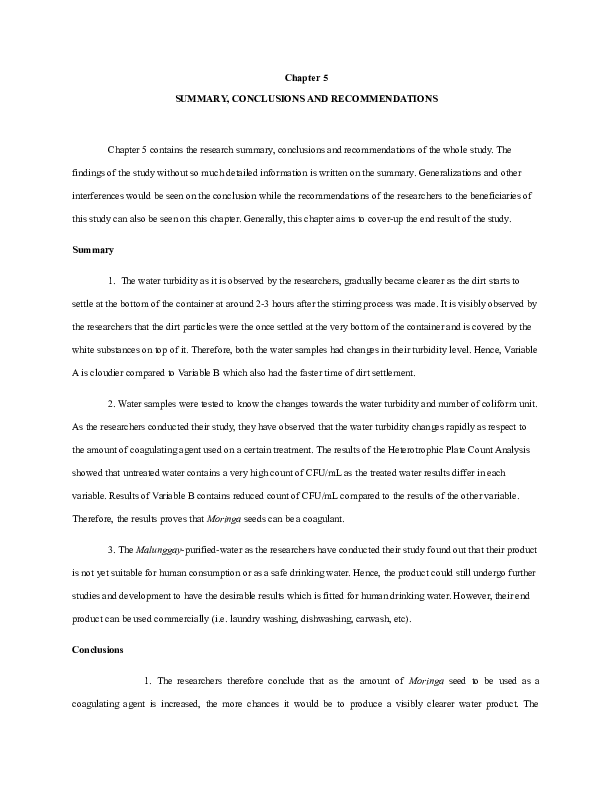
Chapter 5 SUMMARY, CONCLUSIONS AND RECOMMENDATIONS

Related Papers
Human movement science
Peter H . Wilson
Best Practice & Research Clinical Endocrinology & Metabolism
Imran Mushtaq
Linda Isherwood
CLIC Note, to be …
Barbara Dalena , D. Adams
R. Tomás 1 , E. Adli 1 , I. Ahmed 2 , PK Ambatu 3 , D. Angal-Kalinin 4 , R. Barlow 4&6 , JP Baud 5 , ... B. Bolzon 5 , H. Braun 1 , H. Burkhardt 1 , GC Burt 4 , R. Corsini 1 , B. Dalena 1 , AC Dexter 3 , ... V. Dolgashev 7 , K. Elsener 1 , JL Fernandez Hernando 4 , G. Gaillard 5 , N. Geffroy ...
Hormone Research in Paediatrics
Jillian Bryce
Background: Research and audit are vital for the management of Differences/Disorders of Sex Development (DSD). Clinical networks have a strong potential to drive these activities with the development of care standards including patient experience data and peer-observation of clinical care provision. Summary: Following the 2005 Consensus Workshop that stressed the need for the regular collection and sharing of data across geographical boundaries, the current I-DSD registry was initially launched in 2008. Over a decade later, this registry and its associated network play an increasingly important role in supporting research, training, and benchmarking of care and service. Patient registries can also facilitate the development of local circles of patients and parents with similar conditions who can support each other. Key Messages: The case for participating in standardized data collection and exchange for DSD has now been made and should be standard practice in centres that care for p...
Developmental Medicine and Child Neurology
Michael E . Stone
Address given in Sydney in Sept. 2014 to the Australian Friends of the Hebrew University and the Sir Zelman Cowan Universities Fund.
Advances in urology
Juerg C Streuli
Brian Cuthbertson
Environmental Research
Graham Colditz
RELATED PAPERS
Khozin Busyro
Syntax Literate ; Jurnal Ilmiah Indonesia
Maulida Fauziah
New England Journal of Medicine
Gilles Blasco
Physical Review E
Eugene Terentjev
Sarah Fortner
Walter Moure
Nguri Nguri T O S A N A J I Jakarta
Egyptian Academic Journal of Biological Sciences, E. Medical Entomology & Parasitology
Mostafa Hassan
Pakistan Journal of Biological Sciences
Ainul Mardiah
Frontiers in Microbiology
Valme Jurado
Natalia Cojocaru
Pensa E-Jurnal: Pendidikan Sains
Ericha Marviyani
Byzantium and the Emergence of Muslim-Turkish Anatolia, ca. 1040–1130
Alexander Beihammer
Biologia Plantarum
Marcin Przewloka
Derk Jan Stobbelaar
Analytical Letters
Florina Covaciu
Journal of Public Policy
Robert Dekle
Tạp chí Y Dược học Cần Thơ
Applied Surface Science
Enno Arenholz
Brayan Gomez
Canadian Mineralogist
Tom McCandless
Lettera matematica PRISTEM
Prof. Dr. Raffaele Pisano, HDR (Habil.) & Linus Pauling Memorial | Elected Member of CNU 72
Parasitology Research
Cilmery Kurokawa
Real Estate Economics
Crocker Liu
See More Documents Like This
- We're Hiring!
- Help Center
- Find new research papers in:
- Health Sciences
- Earth Sciences
- Cognitive Science
- Mathematics
- Computer Science
- Academia ©2024
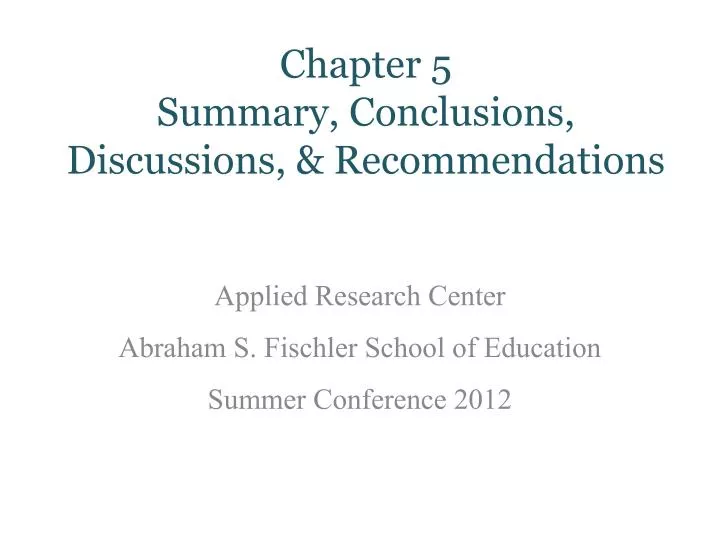
Chapter 5 Summary, Conclusions, Discussions, & Recommendations
Jul 29, 2014
2.15k likes | 6.14k Views
Chapter 5 Summary, Conclusions, Discussions, & Recommendations . Applied Research Center Abraham S. Fischler School of Education Summer Conference 2012. General Information. This session will address the components of Chapter 5 of the Applied Dissertation.
Share Presentation
- straightforward manner
- statistical jargon
- liberal statistics
- health promotion
- education summer conference

Presentation Transcript
Chapter 5 Summary, Conclusions, Discussions, & Recommendations Applied Research Center Abraham S. Fischler School of Education Summer Conference 2012
General Information This session will address the components of Chapter 5 of the Applied Dissertation. The format and style of Chapter 5 should follow the Style Guide for the Applied Dissertationand the sixth edition of the APA manual.
Chapter 5 Purpose of Chapter 5: To provide the readers with a thorough understanding of what the results of your study mean to the research field and to professional practice.
Chapter 5 Chapter 5 allows you to summarize the findings, discuss the importance of the findings, place the research findings in the context of current literature, compare and contrast the research findings with other relevant research, identify the strengths and weaknesses of the research study, discuss the implications of the research findings, and make recommendations for future research.
Summary of Findings Restate the results presented in Chapter 4 using little or no statistical jargon. Write in a clear straightforward manner with no interpretation of the results. Use past tense. Do not include tables and figures. Identify whether the findings of your study supported the hypotheses or research questions. Present unusual findings (e.g., results that you did not expect to be significant but were, and vice versa).
Interpretation of Findings Analyze both significant findings and not significant findings. Were the results what you predicted? Why do you think the results turned out the way they did? Were there any issues related to sampling, measurement, and procedural issues, as well as confounding variables? Provide possible explanations for the results. Link the results to any theoretical framework you used to develop your research question or hypotheses.
Context of Findings Place your findings in perspective to other studies of the topic found in the reviewed literature. How are your findings similar or different from those of other studies? Based on the literature, are the findings what might have been expected? If your results differ from those of other studies, what plausible explanations can account for this?
Implications of Findings • How do the findings expand the understanding of the phenomenon under study? • Identify the implications of the findings for • Theory: Are findings consistent with current theories in the field? Are they consistent with the selected theoretical framework for your study? • Research: Does the study help advance the research methodology in the field? (e.g., understanding of new confounding variables, issues of measurement, issues of design) • Practice: Who may be interested in using these findings in a professional field? Why should they pay attention to the findings? Could the findings lead to changes in the way professionals “do” things?
Discussion on Limitations Review the potential limitations that you initially proposed in the proposal. Discuss the limitations that may have affected—one way or another—your findings. Limitations typically originate in one of two sources: the study’s design and the study’s problems during implementation. Issues of design involve decisions about sampling, assessment, procedures, and choice of research design (poor match). Some of the issues that may have arisen at the time of research implementation relate to low sample size, measurement issues, heterogeneous groups, and so forth.
Discussion on Limitations (Cont.) Think of limitations in four major areas: Internal Validity—Unless the study is a “true experiment” one cannot claim that the IV “caused” changes in the DV. External Validity—Discuss the extent to which findings can be generalized. Measurement—Discuss issues of reliability and validity of assessment instruments. Statistical Analysis—Discuss issues of power, effect size, conservative or liberal statistics, and statistical test chosen.
Discussion on Future Directions Discuss findings in light of questions or issues that suggest future research directions. Extend the study to other populations. Think of other IVs and DVs that ought to be explored in the field; also, think of how to assess those additional variables. This is the section of the paper where most researchers are allowed to dream; think of extending your study to other questions that may add to the understanding of the issues.
Bibliography Cone, J. D., & Foster, S. F. (2006). Dissertations and theses from start to finish: Psychology and related fields. Washington, DC: American Psychological Association. Cottrell, R. R., & McKenzie, J. F. (2011). Health Promotion and education research methods: Using the five-chapter thesis/dissertation model (2nd ed.). Sudbury, MA: Jones and Bartlett.
- More by User

Technical Recommendations for Highways No 12 TRH 12
Technical Recommendations for Highways No 12 TRH 12. Technical Recommendations for Highways No 12 TRH 12. 1980 1983 – draft TRH 12: Bituminous pavement rehabilitation design 1983 1989 1990
1.29k views • 53 slides

Chapter 8. Producing Summary Reports. Section 8.1. Introduction to Summary Reports. Objectives. Identify the different report writing procedures. Create one-way and two-way frequency tables using the FREQ procedure. Restrict the variables processed by the FREQ procedure.
1.93k views • 158 slides

Chapter 8 Perfect Competition
Chapter 8 Perfect Competition. Key Concepts Summary Practice Quiz Internet Exercises. ©2000 South-Western College Publishing. In this chapter, you will learn to solve these economic puzzles:. Why is the demand curve horizontal for a firm in a perfectly competitive market?.
1.46k views • 95 slides
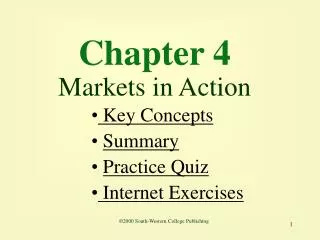
Chapter 4 Markets in Action
Chapter 4 Markets in Action. Key Concepts Summary Practice Quiz Internet Exercises. ©2000 South-Western College Publishing. In this chapter, you will learn to solve these economic puzzles:. How does the spotted owl affect the price of homes?.
1.16k views • 76 slides

Lec 3 Sept 2 complete Chapter 1 exercises from Chapter 1 quiz # 1 Chapter 2 st
Lec 3 Sept 2 complete Chapter 1 exercises from Chapter 1 quiz # 1 Chapter 2 start. Performance Summary. Performance depends on Algorithm: affects IC, possibly CPI Programming language: affects IC, CPI Compiler: affects IC, CPI
1.02k views • 28 slides

Chapter 14 Environmental Economics
Chapter 14 Environmental Economics. Key Concepts Summary Practice Quiz Internet Exercises. ©2000 South-Western College Publishing. In this chapter, you will learn to solve these economic puzzles:.
1.14k views • 77 slides
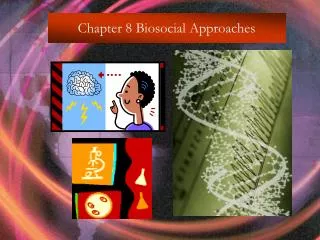
Chapter 8 Biosocial Approaches
Chapter 8 Biosocial Approaches. Chapter Summary. Chapter Eight discusses the importance of both genetic and hereditary influences on criminal behavior as well as the environmental interaction with those genetic & biological mechanisms.
1.04k views • 50 slides

The Word Is Alive 1 Corinthians
The Word Is Alive 1 Corinthians. Chapter Five Narrated by Tony Gillon. Chapter Five. Summary of Chapter Five This brief chapter deals with a specific instance of gross sexual immorality that Paul clearly states must be dealt with.
1.21k views • 102 slides

The Word Is Alive 1 John
The Word Is Alive 1 John. Chapter One Narrated by Tony Gillon. Chapter One. Summary of Chapter One The most eloquent introduction. Chapter One. Summary of Chapter One The most eloquent introduction. God is light. Chapter One. Summary of Chapter One The most eloquent introduction.
1.58k views • 143 slides

The Word Is Alive Galatians
The Word Is Alive Galatians. Chapter Three Narrated by Tony Gillon. Chapter Three. Summary of Chapter Three The theme of justification by faith alone continues. Chapter Three. Summary of Chapter Three The theme of justification by faith alone continues. The promise precedes the law.
2.27k views • 216 slides

The Word Is Alive The Book of Acts
The Word Is Alive The Book of Acts. Chapter Twelve Narrated by Tony Gillon. Chapter Twelve. Summary of Chapter Twelve The martyrdom of James Zebedee. Chapter Twelve. Summary of Chapter Twelve The martyrdom of James Zebedee. King Agrippa arrests Peter. Chapter Twelve.
1.65k views • 126 slides

The Word Is Alive The Gospel of Matthew
The Word Is Alive The Gospel of Matthew. Chapter Four Narrated by Tony Gillon. Chapter Four. Summary of Chapter Four Forty days of testing by the devil. Chapter Four. Summary of Chapter Four Forty days of testing by the devil. Jesus’ teaching ministry commences. Chapter Four.
2.13k views • 203 slides
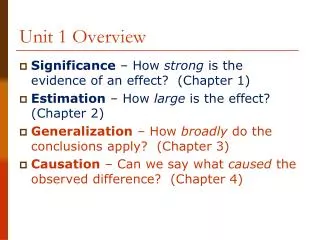
Unit 1 Overview
Unit 1 Overview. Significance – How strong is the evidence of an effect? (Chapter 1 ) Estimation – How large is the effect? (Chapter 2 ) Generalization – How broadly do the conclusions apply? (Chapter 3 ) Causation – Can we say what caused the observed difference? (Chapter 4).
1.19k views • 94 slides


Chapter 13 Flyweight
Chapter 13 Flyweight. Summary prepared by Kirk Scott. Design Patterns in Java Chapter 13 Flyweight. Summary prepared by Kirk Scott. That animal is known as a couscous A trip to Wikipedia will allow you to determine whether it is related to the food named couscous…. Introduction.
1.29k views • 114 slides

The Word Is Alive 1 Timothy
The Word Is Alive 1 Timothy. Chapter Five Narrated by Tony Gillon. Chapter Five. Summary of Chapter Five The need to show respect in church. Chapter Five. Summary of Chapter Five The need to show respect in church. Honouring widows. Chapter Five. Summary of Chapter Five
2.06k views • 191 slides

Chapter 8: IP Addressing
Chapter 8: IP Addressing. Introduction to Networks. Chapter 8. 8 .0 Introduction 8.1 IPv4 Network Addresses 8 .2 IPv6 Network Addresses 8 .3 Connectivity Verification 8.4 Summary. IP Addressing Chapter 8: Objectives. In this chapter, you will be able to:
1.04k views • 88 slides

Audit Engagement Overview
Audit Engagement Overview. Plan. Perform. Communicate. Monitor. Research and apply Standards. Maintain fraud awareness. Assess risk. Collect, evaluate, analyze, interpret data. Report findings, conclusions, recommendations. Monitor engagement outcomes. Develop workpapers.
1.79k views • 69 slides

The Word Is Alive The Gospel of Luke
The Word Is Alive The Gospel of Luke. Chapter Twenty Four Presented by Tony Gillon. Chapter Twenty Four. Summary of Chapter Twenty Four The empty tomb. Chapter Twenty Four. Summary of Chapter Twenty Four The empty tomb. The Emmaus Road. Chapter Twenty Four.
2.38k views • 212 slides

The Word Is Alive 1 Timothy. Chapter Two Narrated by Tony Gillon. Chapter Two. Summary of Chapter Two The requirements for corporate worship. Chapter Two. Summary of Chapter Two The requirements for corporate worship Paul addresses the behaviour in gatherings. Chapter Two.
2.41k views • 225 slides

Chapter 2. THE RELATIONAL MODEL OF DATA. Chapter 2 The Relational Model of Data. 2.1 An Overview of Data Models 2.2 Basics of Relational Model 2.3 Defining a Relation Schema in SQL 2.4 An Algebraic Query Language 2.5 Constraints on Relations 2.6 Summary of Chapter 2
1.36k views • 105 slides

Electralink Customer Survey Presentation 3 rd December 2007
R. Electralink Customer Survey Presentation 3 rd December 2007. Presentation Coverage. Introduction Overview Quantitative Survey Results Focus On DTS Focus On SPAA Focus On DCUSA Qualitative Research Summary & Conclusions Recommendations For 2008 Research. R. Introduction.
1.28k views • 113 slides
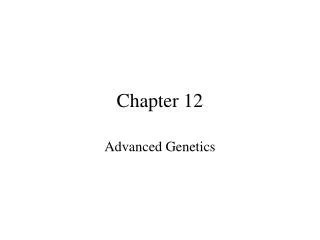
Chapter 12. Advanced Genetics. 11.3 Section Summary 6.3 – pages 296 - 301. Mutations. Mutation: a change in __. May involve : an entire __ a specific __ may take place in __ cell.
996 views • 87 slides

Research Methodology and Scientific Writing pp 93–133 Cite as
Experimental Research
- C. George Thomas 2
- First Online: 25 February 2021
4067 Accesses
Experiments are part of the scientific method that helps to decide the fate of two or more competing hypotheses or explanations on a phenomenon. The term ‘experiment’ arises from Latin, Experiri, which means, ‘to try’. The knowledge accrues from experiments differs from other types of knowledge in that it is always shaped upon observation or experience. In other words, experiments generate empirical knowledge. In fact, the emphasis on experimentation in the sixteenth and seventeenth centuries for establishing causal relationships for various phenomena happening in nature heralded the resurgence of modern science from its roots in ancient philosophy spearheaded by great Greek philosophers such as Aristotle.
The strongest arguments prove nothing so long as the conclusions are not verified by experience. Experimental science is the queen of sciences and the goal of all speculation . Roger Bacon (1214–1294)
This is a preview of subscription content, log in via an institution .
Buying options
- Available as PDF
- Read on any device
- Instant download
- Own it forever
- Available as EPUB and PDF
- Compact, lightweight edition
- Dispatched in 3 to 5 business days
- Free shipping worldwide - see info
- Durable hardcover edition
Tax calculation will be finalised at checkout
Purchases are for personal use only
Bibliography
Best, J.W. and Kahn, J.V. 1993. Research in Education (7th Ed., Indian Reprint, 2004). Prentice–Hall of India, New Delhi, 435p.
Google Scholar
Campbell, D. and Stanley, J. 1963. Experimental and quasi-experimental designs for research. In: Gage, N.L., Handbook of Research on Teaching. Rand McNally, Chicago, pp. 171–247.
Chandel, S.R.S. 1991. A Handbook of Agricultural Statistics. Achal Prakashan Mandir, Kanpur, 560p.
Cox, D.R. 1958. Planning of Experiments. John Wiley & Sons, New York, 308p.
Fathalla, M.F. and Fathalla, M.M.F. 2004. A Practical Guide for Health Researchers. WHO Regional Publications Eastern Mediterranean Series 30. World Health Organization Regional Office for the Eastern Mediterranean, Cairo, 232p.
Fowkes, F.G.R., and Fulton, P.M. 1991. Critical appraisal of published research: Introductory guidelines. Br. Med. J. 302: 1136–1140.
Gall, M.D., Borg, W.R., and Gall, J.P. 1996. Education Research: An Introduction (6th Ed.). Longman, New York, 788p.
Gomez, K.A. 1972. Techniques for Field Experiments with Rice. International Rice Research Institute, Manila, Philippines, 46p.
Gomez, K.A. and Gomez, A.A. 1984. Statistical Procedures for Agricultural Research (2nd Ed.). John Wiley & Sons, New York, 680p.
Hill, A.B. 1971. Principles of Medical Statistics (9th Ed.). Oxford University Press, New York, 390p.
Holmes, D., Moody, P., and Dine, D. 2010. Research Methods for the Bioscience (2nd Ed.). Oxford University Press, Oxford, 457p.
Kerlinger, F.N. 1986. Foundations of Behavioural Research (3rd Ed.). Holt, Rinehart and Winston, USA. 667p.
Kirk, R.E. 2012. Experimental Design: Procedures for the Behavioural Sciences (4th Ed.). Sage Publications, 1072p.
Kothari, C.R. 2004. Research Methodology: Methods and Techniques (2nd Ed.). New Age International, New Delhi, 401p.
Kumar, R. 2011. Research Methodology: A Step-by step Guide for Beginners (3rd Ed.). Sage Publications India, New Delhi, 415p.
Leedy, P.D. and Ormrod, J.L. 2010. Practical Research: Planning and Design (9th Ed.), Pearson Education, New Jersey, 360p.
Marder, M.P. 2011. Research Methods for Science. Cambridge University Press, 227p.
Panse, V.G. and Sukhatme, P.V. 1985. Statistical Methods for Agricultural Workers (4th Ed., revised: Sukhatme, P.V. and Amble, V. N.). ICAR, New Delhi, 359p.
Ross, S.M. and Morrison, G.R. 2004. Experimental research methods. In: Jonassen, D.H. (ed.), Handbook of Research for Educational Communications and Technology (2nd Ed.). Lawrence Erlbaum Associates, New Jersey, pp. 10211043.
Snedecor, G.W. and Cochran, W.G. 1980. Statistical Methods (7th Ed.). Iowa State University Press, Ames, Iowa, 507p.
Download references
Author information
Authors and affiliations.
Kerala Agricultural University, Thrissur, Kerala, India
C. George Thomas
You can also search for this author in PubMed Google Scholar
Corresponding author
Correspondence to C. George Thomas .
Rights and permissions
Reprints and permissions
Copyright information
© 2021 The Author(s)
About this chapter
Cite this chapter.
Thomas, C.G. (2021). Experimental Research. In: Research Methodology and Scientific Writing . Springer, Cham. https://doi.org/10.1007/978-3-030-64865-7_5
Download citation
DOI : https://doi.org/10.1007/978-3-030-64865-7_5
Published : 25 February 2021
Publisher Name : Springer, Cham
Print ISBN : 978-3-030-64864-0
Online ISBN : 978-3-030-64865-7
eBook Packages : Education Education (R0)
Share this chapter
Anyone you share the following link with will be able to read this content:
Sorry, a shareable link is not currently available for this article.
Provided by the Springer Nature SharedIt content-sharing initiative
- Publish with us
Policies and ethics
- Find a journal
- Track your research
Follow Polygon online:
- Follow Polygon on Facebook
- Follow Polygon on Youtube
- Follow Polygon on Instagram
Site search
- What to Watch
- What to Play
- PlayStation
- All Entertainment
- Modern Warfare 3
- FF7 Rebirth
- Zelda: Tears of the Kingdom
- Baldur’s Gate 3
- Buyer’s Guides
- Galaxy Brains
- All Podcasts
Filed under:
- Fortnite guides
What are the new map and weapon loot pool changes in Fortnite Chapter 5 Season 2?
What weapons are new and which weapons got vaulted?
Share this story
- Share this on Facebook
- Share this on Reddit
- Share All sharing options
Share All sharing options for: What are the new map and weapon loot pool changes in Fortnite Chapter 5 Season 2?
/cdn.vox-cdn.com/uploads/chorus_image/image/73192378/GIE4Pa9WkAAQ4Z0.0.jpg)
Fortnite ’s Chapter 5 Season 2 is dubbed “ Myths and Mortals ,” and is full of gods and prominent figures from Greek mythology. The island has also gained points of interest based off of these myths.
It’s no surprise that you’ll see the likes of Zeus, Cerberus, and Artemis roaming around the island (and you can unlock them as skins via the battle pass). There are quite a few other things going around the island, including an updated loot pool with mythics that drop specifically from these NPCs.
Below we explain the map and loot pool changes for Fortnite Chapter 5 Season 2. And for more Fortnite guides, check out our list of all Weapons Bunker locations .
Fortnite map changes for the Chapter 5 Season 2 update
The map has been updated with tons of locations from Greek mythology, including The Underworld, Mount Olympus, and the Brawler’s Battleground (home to Fortnite ’s rendition of Ares). You can see the full map below:
:no_upscale()/cdn.vox-cdn.com/uploads/chorus_asset/file/25330512/Fortnite_Myths___Monsters_map.png)
Fortnite weapon loot pool for the Chapter 5 Season 2 update
:no_upscale()/cdn.vox-cdn.com/uploads/chorus_asset/file/25325275/fortnite_gatekeeper_shotgun_1920x1080_11ced08de565.jpg)
These weapons have been unvaulted for the new season:
- Midas’ Drum Gun
- Hand Cannon
- Impulse Grenade
- Chug Splash
These are also new items added for Chapter 5 Season 2:
- Ares’ Warforged Assault Rifle
- Warforged Assault Rifle
- Drum Gun (epic and legendary)
- Zeus’ Huntress DMR
- Huntress DMR
- Cerberus’ Gatekeeper Shotgun
- Gatekeeper Shotgun
- Hades’ Harbinger SMG
- Harbinger SMG
- Thunderbolt of Zeus
- Wings of Icarus
- Shield Bubble Jr.
Some of the weapons in the above list will only drop from taking on the respective boss. For example, you’ll get the mythic Ares’ Warforged Assault Rifle for eliminating Ares. These bosses do appear to drop medallions , too, just like last season.
What has been vaulted in Fortnite Chapter 5 Season 2?
- Enforcer AR
- Thunder Burst SMG
- Ballistic Shield
- Lock On Pistol
- Grapple Blade
- Anvil Rocket Launcher
- EMP Stealth Camo
- Cardboard Box
- Crash Pad Jr.
In addition to the above, the specialty weapons dropped by bosses (like Montague’s Nemesis AR) have been vaulted, since those are no longer featured bosses. These versions of boss medallions have also been vaulted, though as mentioned above, there are new versions of boss medallions that fit with the season’s theme now.
The next level of puzzles.
Take a break from your day by playing a puzzle or two! We’ve got SpellTower, Typeshift, crosswords, and more.
Sign up for the newsletter Patch Notes
A weekly roundup of the best things from Polygon
Just one more thing!
Please check your email to find a confirmation email, and follow the steps to confirm your humanity.
Oops. Something went wrong. Please enter a valid email and try again.
Loading comments...

Pokémon Go Litten Community Day guide

Taylor Swift: The Eras Tour, Netflix’s Irish Wish, Madame Web, and every new movie to watch this weekend

Queen’s Blood card list in FF7 Rebirth

How to get Sprigatito through Mystery Gift in Pokémon Scarlet and Violet

All the Scream 7 news so far, including its new director

The Teen Titans are getting a live-action movie in James Gunn’s new DC Universe
Read our research on: TikTok | Podcasts | Election 2024
Regions & Countries
5. electoral reform and direct democracy.
Free and fair elections are a critical element of a healthy democratic system . And in many of the 24 countries surveyed, reforming how elections and the electoral system work is a key priority. People want both large-scale, systemic changes – such as switching from first-past-the-post to proportional representation – as well as smaller-scale issues like making Election Day a holiday.
Many people link these changes to greater citizen representation, whether it’s because they allow people to vote more easily or because their votes can be more readily and accurately converted into representation.
But some people take it even a step further, arguing for their country to have more direct democracy . Particularly in France and Germany, where direct democracy is the second-most suggested change, people want to have more chances to vote via referenda on topics that matter to them.
Electoral reform
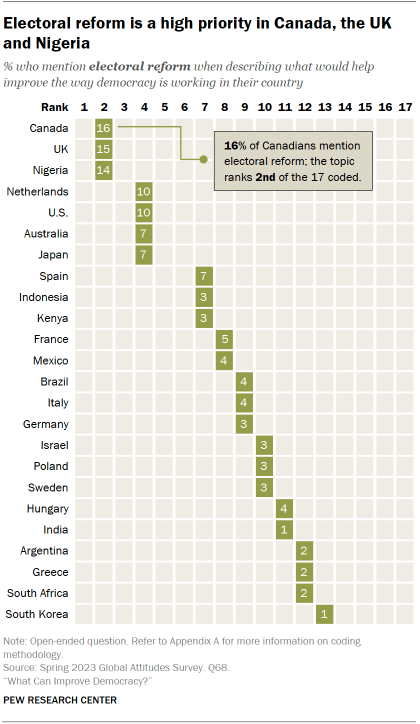
Changing the electoral system appears in the top five ranked issues in seven of the 24 countries surveyed. In Canada, Nigeria and the UK, the issue ranks second among the 17 substantive topics coded.
In six countries, those who do not support the governing party or parties are more likely to mention electoral reform than those who do support such parties. In the UK, for example, where electoral reform is ranked second only to politicians, 17% of those who do not support the ruling Conservative Party mention electoral reform, compared with 6% of Conservative Party supporters. (For more information on how we classify governing party supporters, refer to Appendix D .)
However, in the U.S. and Israel, this pattern is reversed: Those who do support the governing parties are more likely than those who do not to mention electoral reform as an improvement to democracy.
“People should have the right to choose their leaders through a free and fair election.” Woman, 20, Nigeria
Across the countries surveyed, people want to see a wide range of electoral reforms. Some of these focus on the logistics of casting votes – how and when people vote , and who is eligible . Others focus more on changing the electoral system , referencing issues like electoral thresholds and gerrymandering. And some emphasize the need to ensure free and fair elections . In Nigeria and Brazil, people who are not confident that their recent national elections were conducted fairly and accurately (as asked in a separate question in Brazil, Kenya and Nigeria) are more likely to bring up electoral reform.
Logistics of casting votes
Some of the calls for electoral reform center specifically on how ballots are cast. For example, some see benefits to electronic voting options over paper ballots, especially as a tool to protect elections: “Use modernized technology to help in security of the voting system,” said one Kenyan woman. Others see electronic ballots as an issue of convenience, particularly if it means one can vote from the comfort of their own house. As one Canadian man put it: “I think people should be able to vote electronically, using the internet and telephone instead of going to a polling station. It makes it more convenient.”
Still, in some places that have electronic voting, respondents raise concerns about this method. “End the electronic ballot box,” said a Brazilian woman. A man in India expressed his preference for paper ballots : “The use of electronic voting machines should be stopped and bring paper ballots back so that transparent democracy will be seen.”
For some Americans, increased access to absentee or mail-in voting is a specific electoral change they want to see: “Making vote-by-mail standard in every state, giving voters time to vote at their convenience, rather than having to miss work. It also gives them the time to research candidates at their leisure.” Others in the U.S. oppose mail-in voting : “Stop voter fraud! Go back to voting on Election Day. Enough with this all-month voting and mail-in votes,” wrote one American woman. “Stop mail-in ballots unless for military or another exempt person,” echoed a man. There are large partisan divides in U.S. views of voting methods , and more Democrats cast absentee votes than Republicans.
When people vote
People also see the need to change the frequency of elections . Some request fewer elections so that officeholders spend less of their term campaigning for reelection: One Australian man wanted to “lengthen the period between federal elections to five years.” Others want to see more elections, like a Canadian woman who said, “Do not have an election every four years; it should be every two years,” or a Nigerian woman who wanted her government to “conduct elections every two years, or frequently.” One South African woman went so far as to say, “Elections should be held every year.”
Some in the U.S. (where national elections are held on the first Tuesday after the first Monday of November) call for making Election Day a holiday . The U.S. is one of few advanced economies that does not hold elections over the weekend or designate the day a national holiday. For example, one American man said, “Create a national voting holiday to ensure every American has a chance to vote.” Another person said, “Eliminate voter suppression. Make Election Day a national holiday. Make voting as easy as mailing a letter.”
Who gets to vote
Making changes to who is allowed to participate in elections is another means people see to improve their democracy. For example, some want to alter the age at which citizens become eligible to cast their votes . For those who want to lower it, the argument centers around allowing more young people to participate in elections: “Lowering the voting age to 16, now young people have more stake in the game,” suggested a Canadian man. An American man had a similar opinion, saying, “I think lowering the age for voting would help democracy, because many teens as young as 16 already have views about policies in the U.S.”
Not all are in favor of lowering the voting age, however. As one Swedish man put it: “Raise the voting age. People at 18 need to take their electoral mandate more seriously.”
“There should be a voter’s license, and voters should take a civics test. Informed voting is the crux of democracy.” Man, 76, Italy
Others feel voters need to pass a knowledge test in order to cast a vote. “The right to vote should be bound by educational attainment,” said a man in Hungary. An Italian man said, “Those who want to vote should pass a test of general culture before the elections.” And a woman in Sweden was specific on this policy: “One should know what you’re voting for, a little mini test so you know what you’re voting for. A driver’s license to vote.” (For more on perceived citizen responsibility, read Chapter 4 .)
In some countries, though, there are calls to protect people’s existing right to vote . In the U.S., where voter suppression has become an electoral issue, several people were vocal about protecting the right to vote. “Abolish state laws that restrict voters’ rights,” suggested one American man. An Australian man focused specifically on protecting voting rights for Aboriginal people: “Ensure Indigenous voters have the opportunity to vote in all circumstances.” Certain respondents even want to enfranchise new types of voters: “Open the right to vote to all permanent residents, such as all Europeans who live in France,” said one French woman.
Mandatory voting
“To oblige every citizen to vote and influence according to law.” Man, 68, Israel
Respondents in some places went as far as suggesting that voting in elections and referenda be required as a means to improve democracy. One Greek woman said, “All citizens should be forced to vote on very important laws and decisions for the country.” A man in the Netherlands saw mandatory voting as a way to improve voter turnout: “Compulsory voting should be reintroduced. For provincial council elections, turnout is only 50% to 60%. Introducing compulsory voting could improve this.”
Still, not everyone who lives in a country that has mandatory voting approves of it. “Don’t make it compulsory to vote for someone. That way, the people who really care will have their vote and those who don’t care won’t just pick the first person on the sheet or the one with the best name with no idea who they are voting for,” said one Australian woman. Another Australian shared a similar view: “I would like to see the scrapping of compulsory voting, as this will mean political parties will need to work harder for votes.” And, in Argentina, where voting is mandatory for most citizens, some respondents called for its overhaul – “that voting is not compulsory.”
Changing the electoral system
“Election law reform. Stop voting by region and switch to a national election where one can choose the winner based on the highest number of votes nationwide.” Woman, 63, Japan
People also call for a different style of voting than they currently have. For example, some focus on implementing a first-past-the-post voting system (in which people vote for a single candidate and the candidate with the most votes wins). As one Australian man put it: “Introduce first-past-the-post voting , dispensing with preferential voting, as the minor parties are making every government difficult to operate.”
Other people value proportional representation , a system where politicians hold the number of seats proportional to their party’s support in the voting population. “Reintroduce the proportional representation voting system and ensure accountability by elected officials,” said a South African man. And a French woman said, “All representatives should be elected by proportional representation.”
Some expressed frustration with ballots listing a choice of parties instead of specific candidates , as in the case of a Swedish man who said, “Direct election of people, not parties. It is better to vote for a person, you know what they think.” An Australian agreed: “Enhancing the electoral process for Australians to vote for candidates, and less for their parties.”
There are also calls for things like ranked-choice voting (“Ranked-choice voting would limit extremism.”) and two-round voting (“The kind of two-round voting system would improve democracy.”).
But no one system necessarily satisfies everyone. In some countries that already have first-past-the-post voting, for example, there are requests to eliminate it: “Get rid of first-past-the-post. The electoral system needs reform so that the representation by popular votes should have some weight,” said one man in Canada. One Japanese woman said, “Abolish the single-seat constituency system ,” referring to a type of voting that includes first-past-the-post, where one winner represents one electoral district.
Electoral threshold
“The electoral threshold should be raised, there should be fewer and larger parties.” Man, 82, Netherlands
Changes to the electoral threshold , or the minimum share of votes needed for a candidate or party to provide representation, is suggested by some as a way to improve democracy – particularly among those who live in countries with low thresholds and fragmented party systems. In Israel, where the 3.25% electoral threshold leads to many parties participating in each election, one woman said, “Significantly increase the electoral threshold.”
This sentiment is echoed in the Netherlands, where the 0.67% threshold is the lowest in the world . One Dutch man said, “I think a high electoral threshold would be good. This could lead to less fragmentation and speed up decision-making.” Another Dutch man saw this change as a means to improve the overall quality of elections: “Raise the electoral threshold, so that there will be more substance. That way not everyone can just start a party.” The Dutch survey was conducted prior to November 2023 elections , in which the far-right Party for Freedom (PVV) won the most seats in the House of Representatives.
Making all votes count – or count more
Revising the borders of electoral districts is a reform some think could help increase voter representation. Gerrymandering , for example – a term coined in the U.S. to describe the practice of drawing electoral district boundaries in a way that creates an advantage for one party over another – is something that people in multiple countries flagged as a problem. For example, an Australian man said, “If we were to ban gerrymandering then each political group would have an equal chance to be elected.” In the U.S., one man said, “It would help if we got rid of gerrymandering and the Electoral College and things that suppress the majority.”
For others, voter representation is not just about physical electoral districts, but about correcting a perceived imbalance in the value of each vote . A 38-year-old Japanese man suggested “equalizing the value of votes from young people versus those of the elderly. Young people should be entitled to two votes.” This issue was also brought up in Spain: “The best thing would be one person, one vote. That is, that all votes were worth the same, that they were not counted by autonomous communities,” said one man.
The U.S. Electoral College
The Electoral College – the process by which U.S. presidential elections are decided – is a major focus of electoral reform for many Americans. One man’s response summarized this stance: “Abolition of the Electoral College to allow for direct representation of individual voters rather than allowing certain states to be overrepresented compared to their population size.”
Most of the U.S. respondents who mention the Electoral College are against the process, like one woman who said, “We need to do away with the Electoral College. It was a good idea, but now it doesn’t make sense.” For many, it’s an issue of unequal representation: “The Electoral College should go away, and potentially change how senators are allotted. Sparsely populated areas have too much influence while tens of millions of city residents essentially have no say,” said another woman.
Free and fair elections
“Have transparent voting and respect who wins. And the one who loses should help the one who won and move on.” Man, 38, Argentina
People also call for more election integrity . For example, some feel there should be more transparency: “More openness in general election, no corruption, collusion or nepotism,” said a woman in Indonesia. Or, as a Nigerian man put it: “Let us have a free and fair election with transparency.” People are concerned about this issue in advanced economies as well, with one Canadian man saying, “Election integrity needs to be improved, and no outside interference.”
Others emphasize the importance of respecting election results . “Accept when a candidate loses the election and when a candidate is elected,” said a man in Brazil. An Israeli man put it simply: “Respect the results of the elections.”
“Monitor the processes more, so that there is no miscount.” Woman, 23, Mexico
Improving electoral monitoring , or the use of unbiased observers to ensure that elections are free and fair , is also a key change people want: “Supervision over the counting of votes,” as a woman in Israel said.
In Mexico, where President Andrés Manuel López Obrador has sought controversial election reforms that many believe will weaken the country’s National Electoral Institute (INE), there are specific calls to “strengthen the INE instead of wanting to destroy it,” as one man said.
A Nigerian man expressed his wish for a better institutional oversight, saying, “The electoral commission should be independent and free from interference from the ruling party.” Nigeria’s electoral commission faced criticism during the February 2023 presidential election and was accused of delaying election results .
Direct democracy
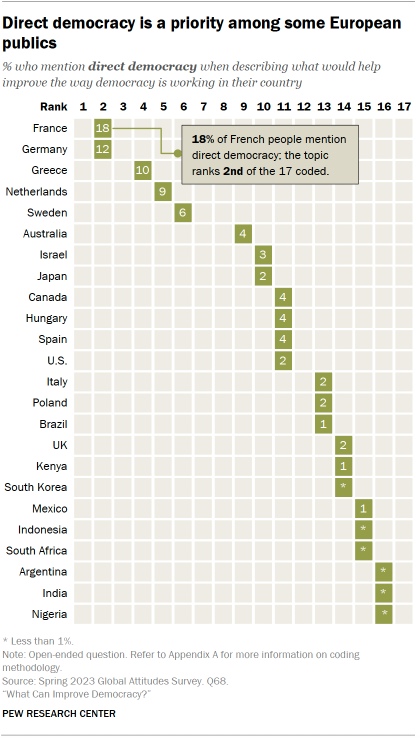
“Consult the French people more often through referendums about important issues, life-changing issues.” Woman, 49, France
For some, a form of government where the public votes directly on proposed legislation or policies is a solution to fixing democracy.
This sentiment is particularly common in European countries: In France, Germany, Greece and the Netherlands, it appears in the top five topics mentioned.
In most other countries, it is less of a priority.
In a handful of countries (Australia, Canada, France, Greece, the Netherlands and the UK), those who do not support the governing party or coalition are more likely to mention direct democracy.
French people stand out as particularly likely to mention direct democracy
In France, direct democracy is the second-most mentioned change people want to see. French people on the ideological left are more likely to bring up this topic than those on the right. Additionally, French adults who believe most elected officials don’t care what people like them think ( as asked in a separate question ) are twice as likely to mention direct democracy as those who say most officials care what they think.
Some in France specifically reference Article 49.3 of the French Constitution , under which the government can push legislation through the National Assembly with no legislative vote: “Article 49.3, which had been established for certain situations, is being used to force through unpopular measures,” said one man. The survey was fielded in France between February and April, a period during which Article 49.3 was used to implement controversial pension reforms . Another French man criticizing Article 49.3 saw direct democracy as a clear solution, saying, “Take into account the opinion of citizens in the form of a referendum. Ask for the citizens’ opinions to avoid passing laws in the form of 49.3.”
The Swiss model
Switzerland’s political system – in which the public is able to vote directly on constitutional initiatives and policy referenda – is perceived positively by others around the world, many of whom want their own country to emulate this model. For example, one Canadian woman said, “If people could vote on important issues like in Switzerland and make decisions on important laws, that’s a true democracy there.”
“More public participation on single important topics, just like the referendums in Switzerland.” Man, 55, Germany
This viewpoint is particularly widespread across European respondents; many want their country’s democracy to resemble Switzerland’s. “It would be a good idea to go back and make decisions much more collegially, like the Swiss system,” said a French man. And a Swedish woman said, “More referenda on nuclear power, sexuality, NATO and the EU. Like Switzerland, which has referendums on many issues.” (The survey was conducted prior to Sweden joining NATO in March 2024.)
Respondents in many countries highlight the benefits of more referenda , or instances where the public votes directly on an issue. For some, a key factor is the frequency of voting . One Kenyan man responded, “Citizens should have a referendum at least once in a while to decide on major issues that affect the country.” And a German woman asked that “more referendums take place.”
“More citizen participation in real decision-making. In other countries, referendums are held expressing opinions on different issues, not like here where they vote every four years.” Man, 41, Spain
In other cases, referenda are seen as opportunities for the government to seek the public’s approval . A Mexican man explained, “Before becoming legal, reforms should pass through a citizen filter and popular consultation.” This sometimes includes ensuring that more marginalized voices get a chance to weigh in. For example, one Israeli man said, “When enacting any law, there should be a referendum where all citizens vote, whether Arabs or Jews.” And an Australian woman wished to see more perspectives reflected, calling for “more direct democracy, and more opportunities for influence by poor, multicultural and minority groups.”
In the UK, where a controversial June 2016 referendum resulted in the UK departing the European Union (known as Brexit), some still express support for direct democracy. A British woman suggested, “We need to put down more questions more polls for the public to choose new policies, new laws.” One British man even noted that a referendum could undo Brexit: “We should have a referendum that is truly reflective about Brexit and rejoining the EU.” But other Britons are more wary of direct democracy: One man said, “We should not allow the general public to make critical decisions. The general public should not be allowed to make economic decisions, for example, Brexit.”
Facts are more important than ever
In times of uncertainty, good decisions demand good data. Please support our research with a financial contribution.
Report Materials
Table of contents, freedom, elections, voice: how people in australia and the uk define democracy, global public opinion in an era of democratic anxiety, most people in advanced economies think their own government respects personal freedoms, more people globally see racial, ethnic discrimination as a serious problem in the u.s. than in their own society, citizens in advanced economies want significant changes to their political systems, most popular.
About Pew Research Center Pew Research Center is a nonpartisan fact tank that informs the public about the issues, attitudes and trends shaping the world. It conducts public opinion polling, demographic research, media content analysis and other empirical social science research. Pew Research Center does not take policy positions. It is a subsidiary of The Pew Charitable Trusts .

We May Finally Know How The First Cells on Earth Formed
T he story of how life started on Earth is one that scientists are eager to learn. Researchers may have uncovered an important detail in the plot of chapter one: an explanation of how bubbles of fat came to form the membranes of the very first cells.
A key part of the new findings, made by a team from The Scripps Research Institute in California, is that a chemical process called phosphorylation may have happened earlier than previously thought.
This process adds groups of atoms that include phosphorus to a molecule, bringing extra functions with it – functions that can turn spherical collections of fats called protocells into more advanced versions of themselves, able to be more versatile, stable, and chemically active.
These protocells are widely thought to have been vital building blocks for biochemistry more than 3.5 billion years ago, perhaps emerging from hot springs under the ocean along the way to the evolution of more complex biological structures.
"At some point, we all wonder where we came from," says chemist Ramanarayanan Krishnamurthy, from The Scripps Research Institute. "This finding helps us better understand the chemical environments of early Earth so we can uncover the origins of life and how life can evolve on early Earth."
Krishnamurthy and his colleagues hypothesized that because the process is so widespread in the body's biological functions, phosphorylation ought to have been involved in early stages of protocell formation.
Replicating conditions likely to match Earth's early days in the lab, the team combined chemicals such as fatty acids and glycerol to try and create more complex vesicles – bubble-like structures similar to protocells that facilitate cellular processes.
With some tweaking of temperature and acidity, the researchers were able to get the chemical reactions they were looking for, proving that phosphorylation may have been at work as protocells developed in the primordial ooze.
"The vesicles were able to transition from a fatty acid environment to a phospholipid environment during our experiments, suggesting a similar chemical environment could have existed four billion years ago," says chemist Sunil Pulletikurti, from The Scripps Research Institute.
The team describes it as a "plausible pathway" for the creation of phospholipids, the more complex type of vesicle membrane. However, there's lots more study to do before we can be sure about how life came to be on Earth .
Looking back billions of years isn't easy of course, but scientists continue to make discoveries about what happened right after Earth formed, and it all plays into our investigations into life on other planets , too.
"It's exciting to uncover how early chemistries may have transitioned to allow for life on Earth," says biophysicist Ashok Deniz, from The Scripps Research Institute.
"Our findings also hint at a wealth of intriguing physics that may have played key functional roles along the way to modern cells."
The research has been published in Chem .


IMAGES
VIDEO
COMMENTS
embodies sarcasm as part a casual form of language use between them. 5.4 Conclusio ns The conclusions of the findings for the four research questions on the examination of
The Purpose of Chapter 5Topic 2: Chapter 5. The Purpose of Chapter 5. Topic 2: Chapter 5. Learning Goals: Understand the components of Chapter 5. Write the introduction to include the problem, purpose, research questions and brief description of the methodology. Review and verify findings for the study. Write the Summary of Findings.
Overview of Chapter 5. A well-written Chapter 5 should include information about the following: Summary of findings. Interpretation of findings. Context of findings. Implications of findings. Discussion on limitations of study. Discussion on future directions of research/field.
Present Demographics. Present the descriptive data: explaining the age, gender, or relevant related information on the population (describe the sample). Summarize the demographics of the sample, and present in a table format after the narration (Simon, 2006). Otherwise, the table is included as an Appendix and referred to in the narrative of ...
5.1 The Abstract. The abstract of a research paper contains the most critical aspects of the paper: your research question, the context (country/population/subjects and period) analyzed, the findings, and the main conclusion. You have about 250 characters to attract the attention of the readers. Many times (in fact, most of the time), readers ...
method/s of research employed. statistical treatment/s applied, or hypotheses tested, if there is any; and; results. If you notice, all the parts mentioned above are already included in your Chapters 1- 4. So, the challenge is on how you are going to write and present it in Chapter 5 briefly.
Sharing an outline of chapter four and five general sections enables dissertation. online mentors teach how to write chapter four and five to dissertation students. Gathering and analyzing data should be fun; the student's passion clearly present in the. last two chapters of the dissertation.
Introduction The following chapter concludes this report. A summary of the research is presented, and findings of the study are discussed and interpreted. The significance of this research in the immediate context of El Gallo and in the field of low-income housing is examined. Recommendations for further research end the chapter. The scope of the following conclusions is limited to the context ...
Recommendations for Future Research for each Variable When following the traditional format for chapter 5 where conclusions, discussion, implications and recommendations were separate sections, the narrative read choppy and ... Since flexibility was an integral part of this study, it is recommended that future
Research Study Findings and Conclusions. Chapter 5: Home. Welcome to Chapter Five ; Chapter 5 Webinars; Alignment of Dissertation Components for DIS-9904ABC
of this report discuss the investigation in three parts: first, a summary of study's research design and results; second, a positing of the implications of those results; and third, a proffering of two kinds of recommendations—(a) for further research, and (b) for future directions in policy making and professional development planning.
1. The Title. The title should be specific and indicate the theme of the research and what ideas it addresses. Use keywords that help explain your paper's topic to the reader. Try to avoid abbreviations and jargon. Think about keywords that people would use to search for your paper and include them in your title. 2.
Chapter 5: The Literature Review. Describe a literature review and explain its purpose. Describe the steps in undertaking a literature review. Write a literature review. Identify acceptable sources to include in your literature review. Apply the five 'C's of writing a literature review. Compare a literature review, an essay and an annotated ...
PDF | Chapter 5 consists of three parts, namely: (1) Summary of the Problems, Method and Findings; (2) Conclusions; and (3) Recommendations. Part One,... | Find, read and cite all the research you ...
Dissertation Chapter 5 Sample. be research. CHAPTER V: DISCUSSION be. The purpose of this qualitative grounded theory study was to identify what motivates. Outline the organization. women to stay in or return to STEM professions, leading to a model of motivation. This.
See Full PDFDownload PDF. Chapter 5 SUMMARY, CONCLUSIONS AND RECOMMENDATIONS Chapter 5 contains the research summary, conclusions and recommendations of the whole study. The findings of the study without so much detailed information is written on the summary. Generalizations and other interferences would be seen on the conclusion while the ...
5 parts of research paper. 1. Seeing Your Paper as a Whole Jrobles10-11. 2. • CHAPTER 1 THE PROBLEM AND ITS BACKGROUND • CHAPTER 2 REVIEW OF RELATED LITERATURE • CHAPTER 3 METHOD AND PROCEDURES • CHAPTER 4 PRESENTATION, ANALYSIS AND INTERPRETATION OF DATA • CHAPTER 5 SUMMARY, CONCLUSIONS AND RECOMMENDATIONS • Others. 3.
Chapter 5 Summary, Conclusions, Discussions, & Recommendations Applied Research Center Abraham S. Fischler School of Education Summer Conference 2012 General Information This session will address the components of Chapter 5 of the Applied Dissertation. The format and style of Chapter 5 should follow the Style Guide for the Applied Dissertationand the sixth edition of the APA manual.
Chapter 5 Experimental Research The strongest arguments prove nothing so long as the conclusions are not verified by experience. Experimental science is the queen of sciences and the goal of all speculation. Roger Bacon (1214-1294) Experiments are part of the scientific method that helps to decide the fate of two
10. The findings should be textual generalization, that is a summary of the important data consisting of text and numbers. 3. 11. Only the important findings, the highlights of the data, should be included in the summary. 4. 12. 5 Findings are not explained nor elaborated upon anymore.
Conclusions Based on the findings of the study, the following conclusions are drawn: 1. The researchers conclude that the Filipino tour guide should have enough skills and knowledge to be an effective leader. 3. 70 EULOGIO "AMANG" RODRIGUEZ INSTITUTE OF SCIENCE AND TECHNOLOGY COLLEGE OF HOSPITALITY MANAGEMENT 2.
took part in this research was 118. Interviews were conducted with 118 respondents using a prepared structured pre-tested interview schedule. The interview schedule was coded for easy analysis and analised using the SPSS computer program. The findings were presented and discussed in chapter 4 by making use of frequency tables, bar and pie graphs.
PARTS OF RESEARCH. Chapter I- Introduction Chapter 2- Review of Related Literature and Studies Chapter 3- Methodology Chapter 4- Presentation, Analysis, and Interpretation of Data Chapter 5- Summary, Findings, Conclusions and Recommendations CHAPTER 1 INTRODUCTION Background of the Study Objectives of the Study Hypotheses Theoretical Framework Conceptual Framework Scope of the Study ...
Evidence-based practice in nursing involves providing holistic, quality care based on the most up-to-date research and knowledge rather than traditional methods, advice from colleagues, or personal beliefs. Nurses can expand their knowledge and improve their clinical practice experience by collecting, processing, and implementing research findings.
Fortnite's Chapter 5 Season 2 is dubbed "Myths and Mortals," and is full of gods and prominent figures from Greek mythology. The island has also gained points of interest based off of these ...
In Fortnite Chapter 2 new bosses were dropped on to the island for the first time, and since then there has been at least one available boss fight within the Battle Royale at any given turn. These ...
New locations added to Fortnite's new Chapter 5 Season 2 map The new Fortnite map has brought with it locations directly inspired by Greek mythology . Brawler's Battleground : This is an area ...
Fortnite Chapter 5 Season 2 has finally dropped, and the new Greek mythology theme has taken over the map. This means new POIs, and even new mythical weapons available on the map. However, one of the most important parts of a new Fortnite season is the new Weekly Challenges that are available.
Free and fair elections are a critical element of a healthy democratic system.And in many of the 24 countries surveyed, reforming how elections and the electoral system work is a key priority. People want both large-scale, systemic changes - such as switching from first-past-the-post to proportional representation - as well as smaller-scale issues like making Election Day a holiday.
A key part of the new findings, made by a team from The Scripps Research Institute in California, is that a chemical process called phosphorylation may have happened earlier than previously ...